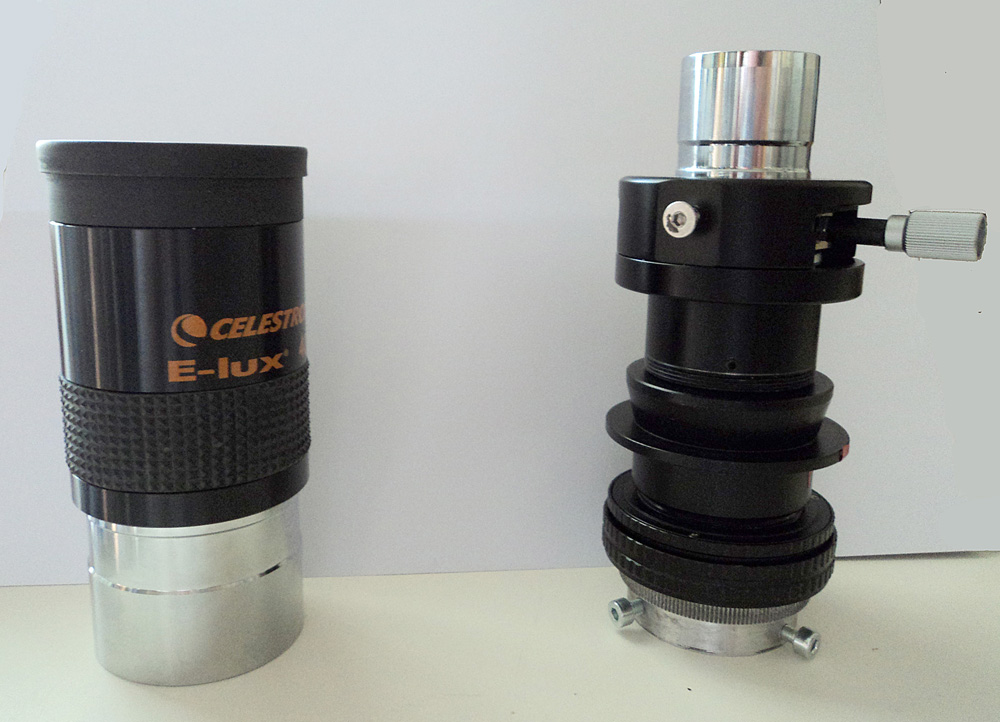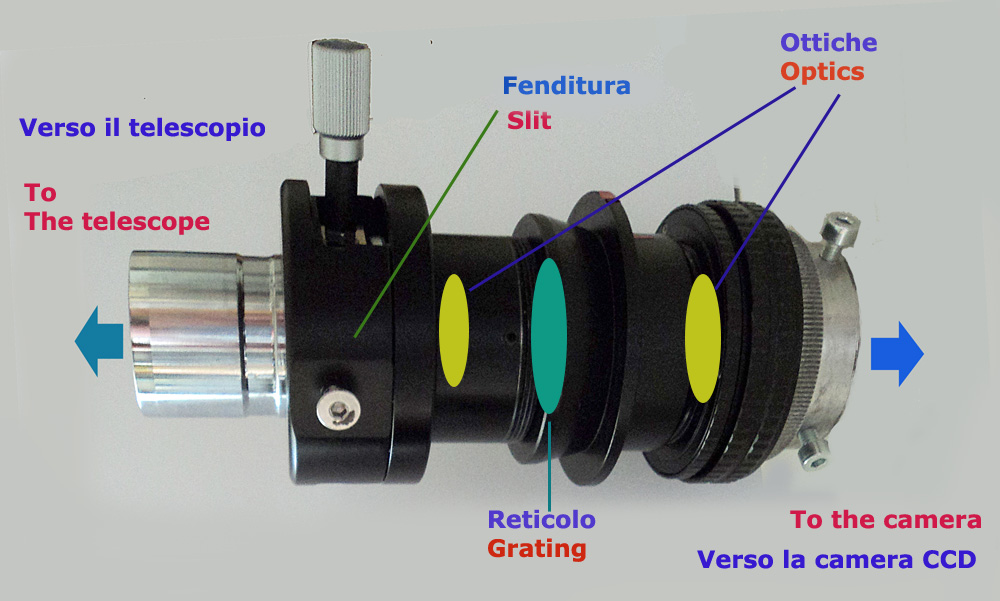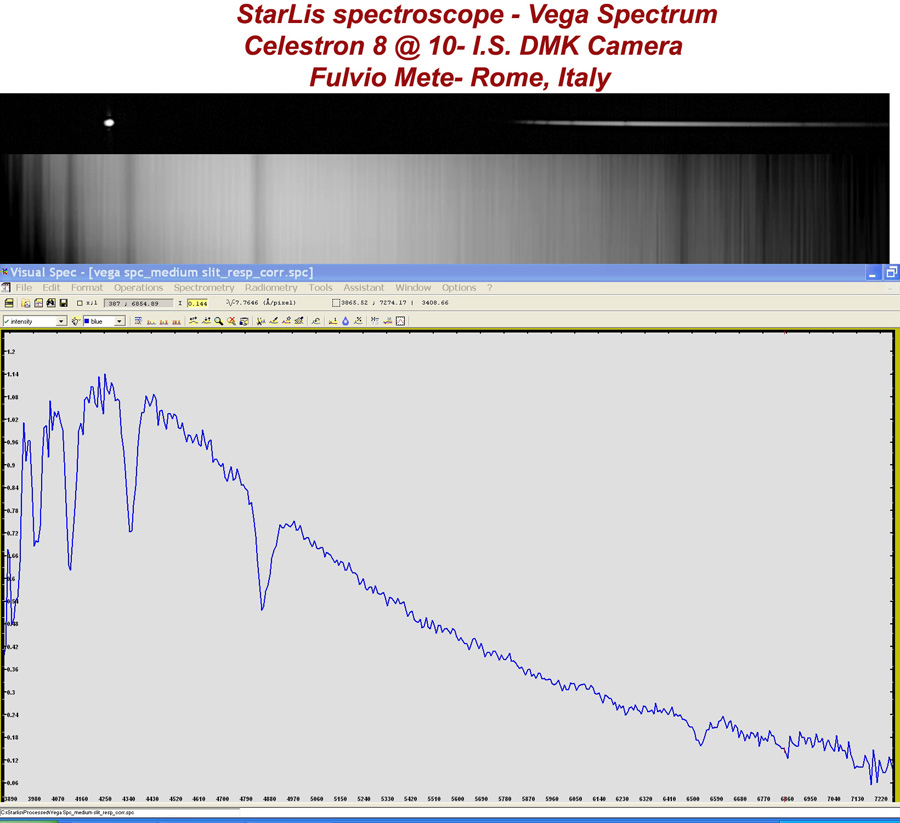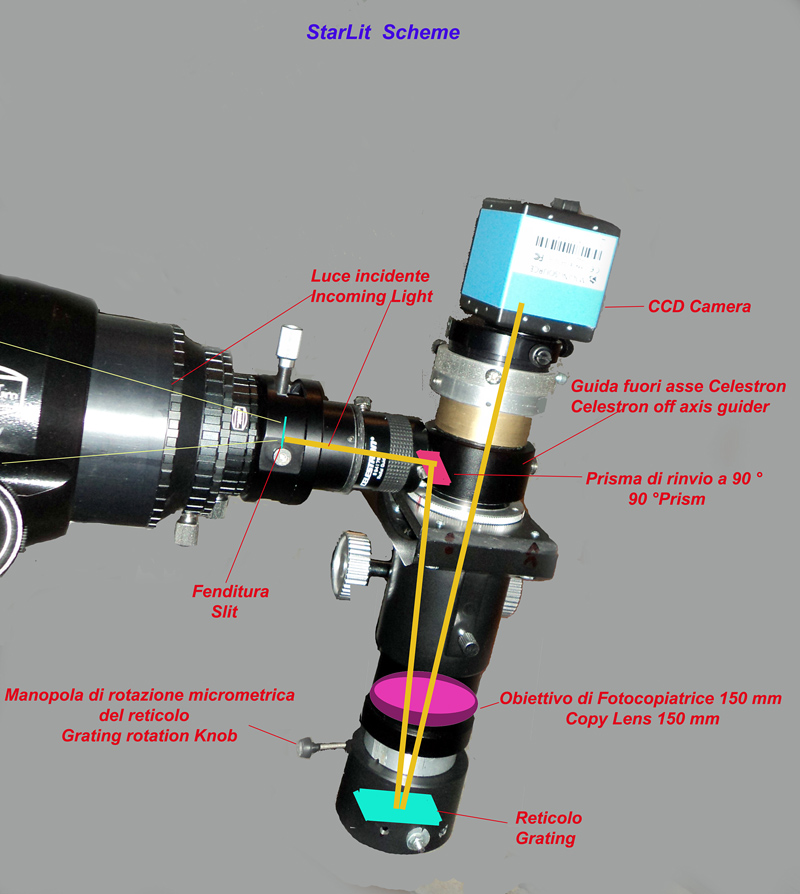
Spettroscopia stellare a bassa e media risoluzione
oltre lo "Star Analyser"
Stellar low and medium resolution spectroscopy: beyond the "Star analyser"
Starlit
E’ da tempo che avevo in mente la costruzione di uno spettroscopio stellare, di peso e dimensioni contenute a risoluzione medio- bassa, ma superiore all’ottimo Star Analyser.
In realtà i prodotti sono stati due:
Il primo, Starlit,(acronimo di Star Littrow) è uno spettroscopio autocollimante, di dimensioni contenute, ma avvertibili, costruito intorno ad un reticolo a riflessione Edmund da 150 l/mm di 30 mm di lato, di risoluzione spettrale teorica di 4500.Mi sembra uno strumento facilmente usabile anche da telescopi e montature medie (ca 1Kg di peso per 30 cm di lunghezza) reticolo facilmente intercambiabile.Nell’immagine allegata si osserva applicato ad un rifrattore TMB 115/7, quindi uno strumento medio.La dispersione, misurata con una camera DMK 41,con pixel da 4.65 micron,sullo spettro di Sirio, stata di 3 A/pixel.l'Ottica, di recupero e di prezzo veramente modesto, è stata un obiettivo da fotocopiatrice di 150 mm di focale.Il sistema di deviazione del fascio ottico è stato ottenuto con la modifica di una guida fuori asse commerciale Celestron.In pratica tale strumento pesa meno della metà di CLAUS (il mio spettroscopio a lente cilidrica) che, con i suoi 2,5 Kg , che divengono 3-4 Kg applicandovi una camera di medie dimensioni, resta di difficile utilizzo per chi abbia strumenti, come molti rifrattori, con sistemi di messa a fuoco crayford o a cremagliera.

Qui di seguito i risultati dl primo test su una stella luminosa, Sirio.Ben visibili e pronunciate, come debbono, le righe della serie di Balmer dell'Idrogeno nel Blu.
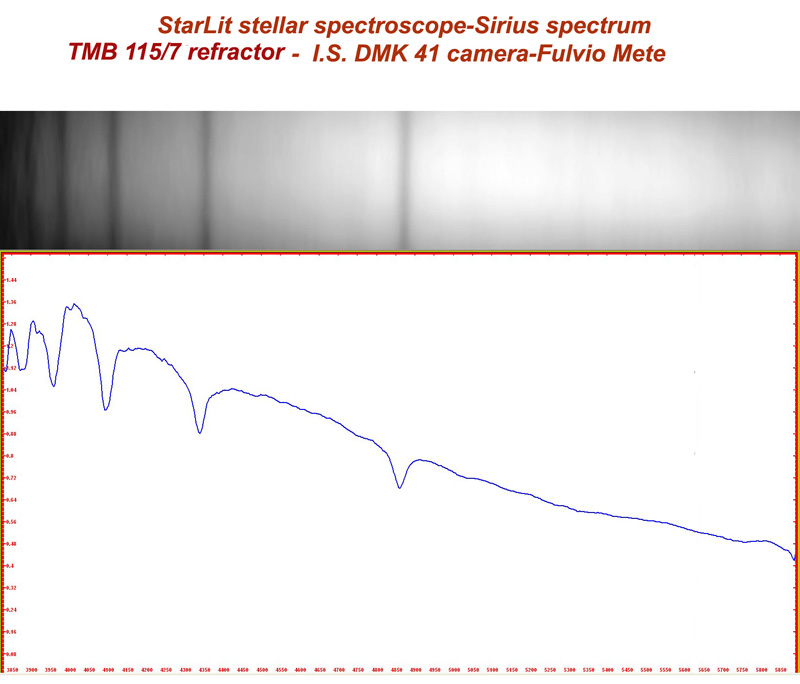
Starlis
Volevo, tuttavia, lo spettroscopio più piccolo che ci possa essere, un livello più su dello S.A, ma usabilissimo anche con telescopi e montature veramente modesti.In questi giorni l’ho assemblato con materiale a disposizione, tra cui gruppi ottici di obiettivi fotografici e una fenditura di Surplushed: il cuore è (ovviamente) lo Star Analyser, ma possono essere usati vari tipi di reticoli a trasmissione, suppongo tuttavia non oltre le 150 l/mm,(forse 200) in quanto trattasi di spettroscopio “classico” con le ottiche in linea col raggio diffratto che esce dallo SA.
Il nome è simile al precedente Starlis,(Star Light Spectroscope) ma fra i due esiste un abisso quanto a peso, dimensioni ed usabilità.Il peso di quest’ultimo strumento è infatti di soli 500 grammi per 12 cm di lunghezza e 60 mm di diametro max, quindi quanto quello di un oculare da 50 mm a lungo fuoco, come si vede nell’immagine, dove sono confrontate le rispettive dimensioni.La somiglianza dei nomi con lo strumento precedente implica anche quella in una certa intercambiabilità di componenti: la fenditura è (per ora ) la stessa, dato che la originaria fenditura di SS è stata pesantemente modificata inserendola in un sistema con innesto 31,8 maschio da una parte, ed a vite 42 x1 dall’altro, in modo che la stessa può essere facilmente smontata e rimontata.In prosieguo, comunque , le fenditure saranno diverse.
La dispersione di Starlis è di 7,7 A/pixel, misurata su una fenditura molto aperta (ca 1 mm) data la scarsa sensibilità della camera usata, una videocamera Imaging Source DMK 41, ottima per riprese planetarie , ma poco adatta in spettroscopia.L’uso di tale camera è stato volutamente dettato dalla volontà di vedere come lo strumento si comporta con CCD non dedicati, come videocamere e webcam, diffusissime tra gli amatori.
Nell’immagine relativa è riportato lo spettro di Vega, come registrato dalla camera con l’ordine 0, la sua elaborazione ed il profilo spettrale corretto per la risposta con VSpec.La praticità dell’oggetto è che rientra nel campo anche l’immagine della stella di ordine 0, sulla quale può effettuarsi la messa a fuoco e la guida.Penso inoltre che chiudendo ulteriormente la fenditura la dispersione e risoluzione spettrale possa ulteriormente, anche se di molto, migliorare.
Avevo in un primo tempo pensato ad aggiungere una guida fuori asse per la guida,ma ci ho ripensato, per la difficoltà di porre la stella di guida di ordine 0 sul chip di guida e lo spettro su quello di ripresa.Ho, invece, pensato adusare un beam splitter 30/70 (30% di luce dal lato guida e 70% dal lato ripresa), con una perdita di luce tutto sommato accettabile: sarà la mia prossima prova con lo strumento.
